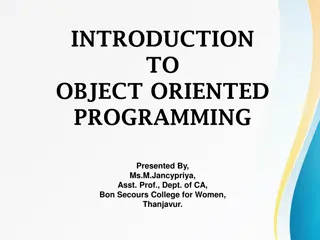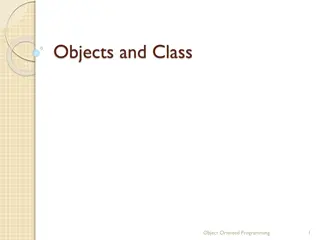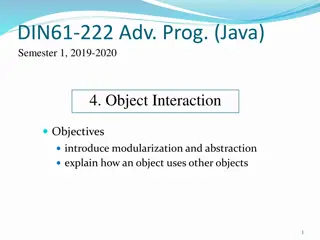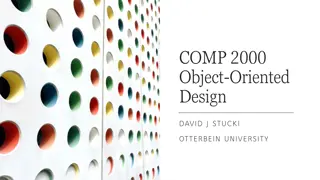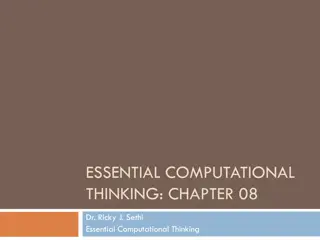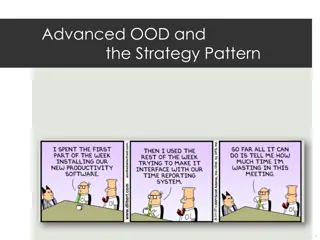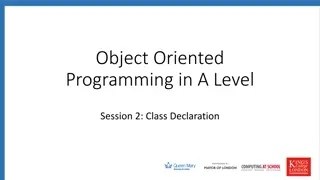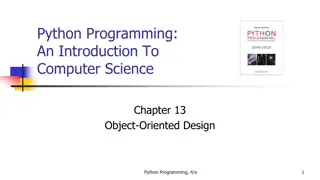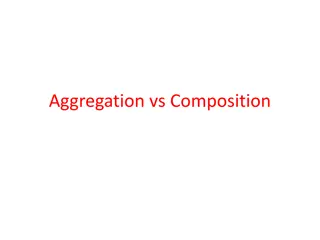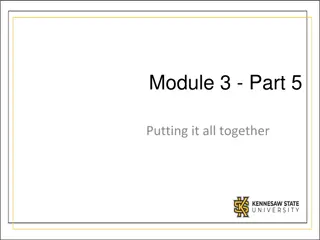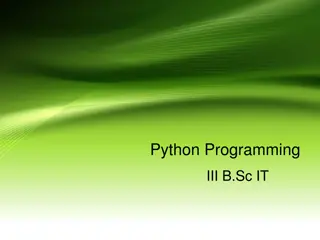Introduction to Object-Oriented Programming and Data Abstraction
Introduction to object-oriented programming concepts including classes, objects, member functions, constructors, destructors, and abstract data types. Exploring the principles of abstraction in software development, passing objects to functions, and understanding the limitations of procedural programming. Learn how abstraction allows programmers to design solutions without worrying about implementation details.
- Object-Oriented Programming
- Data Abstraction
- Abstract Data Types
- Procedural Programming
- Software Development
Download Presentation

Please find below an Image/Link to download the presentation.
The content on the website is provided AS IS for your information and personal use only. It may not be sold, licensed, or shared on other websites without obtaining consent from the author. Download presentation by click this link. If you encounter any issues during the download, it is possible that the publisher has removed the file from their server.
E N D
Presentation Transcript
TOPICS Abstract Data Types Object-Oriented Programming Introduction to Classes Creating and Using Objects Defining Member Functions Constructors Destructors Private Member Functions
TOPICS (CONTINUED) Passing Objects to Functions Object Composition Separating Class Specification, Implementation, and Client Code
ABSTRACT DATA TYPES Are programmer-created data types that specify the legal values that can be stored the operations that can be done on the values The user of an abstract data type (ADT) does not need to know any implementation details (e.g., how the data is stored or how the operations on it are carried out)
ABSTRACTION IN SOFTWARE DEVELOPMENT Abstraction allows a programmer to design a solution to a problem and to use data items without concern for how the data items are implemented This has already been encountered in the book: To use the pow function, you need to know what inputs it expects and what kind of results it produces You do not need to know how it works
ABSTRACTION AND DATA TYPES Abstraction: a definition that captures general characteristics without details ex: An abstract triangle is a 3-sided polygon. A specific triangle may be scalene, isosceles, or equilateral Data Type: defines the kind of values that can be stored and the operations that can be performed on the values
OBJECT-ORIENTED PROGRAMMING Procedural programming focuses on the processes/ actions that occur in a program. Data and functions are separate and distinct. Object-oriented programming is based on objects that encapsulate the data and the functions that operate with and on the data.
LIMITATIONS OF PROCEDURAL PROGRAMMING Use of global data may allow data corruption Programs are often based on complex function hierarchies difficult to understand and maintain difficult to modify and extend easy to break
OBJECT-ORIENTED PROGRAMMING TERMINOLOGY class: similar to a struct Allows bundling of related variables (member data) and the functions that operate on them (member functions) Describes the properties that all instances of the class will have object: an instance of a class, in the same way that a variable can be an instance of a struct
OBJECT-ORIENTED PROGRAMMING TERMINOLOGY attributes: the data items of an object, stored in member variables member functions (methods): procedures/ functions that act on the attributes of the class
MORE OBJECT-ORIENTED PROGRAMMING TERMINOLOGY data hiding: restricting data access to certain members of an object. Protection provide a layer of protection against inadvertent or deliberate data corruption Need-to-know the programmer needn t worry about implementation details when writing client code encapsulation: the bundling of an object s data and procedures into a single entity
OBJECT EXAMPLE Square Member variables (attributes) int side; Member functions void setSide(int s) int getSide() Square object s data item: side Square object s functions: setSide -set the size of the side of the square,getSide -return the size of the side of the square
INTRODUCTION TO CLASSES Class: a programmer-defined data type used to define objects It is a pattern for creating objects ex: string fName, lName; This creates two objects of the string class
INTRODUCTION TO CLASSES A class declaration describes the member variables and member functions that its objects will have It is a pattern for creating objects declaration format: class className { declaration; declaration; }; Note the required ;
ACCESS SPECIFIERS Used to control access to members of the class. Each member is declared to be either public: can be accessed by functions outside of the class or private: can only be called by or accessed by functions that are members of the class
CLASS EXAMPLE class Square { private: int side; public: void setSide(int s) { side = s; } int getSide() { return side; } }; Access specifiers
MORE ON ACCESS SPECIFIERS Can be listed in any order in a class Can appear multiple times in a class If not specified, the default is private
CREATING AND USING OBJECTS An object is an instance of a class It is defined just like other variables Square sq1, sq2; It can access members using dot operator sq1.setSide(5); cout << sq1.getSide();
DEFINING MEMBER FUNCTIONS Member functions are part of a class declaration Place entire function definition inside the class declaration, or Place just the prototype inside the class declaration and write the function definition after the class
TYPES OF MEMBER FUNCTIONS Acessor, get, getter function: uses but does not modify a member variable ex: getSide Mutator, set, setter function: modifies a member variable ex: setSide
DEFINING MEMBER FUNCTIONS INSIDE THE CLASS DECLARATION Member functions defined inside the class declaration are called inline functions Only very short functions, like the one below, should be inline functions int getSide() { return side; }
INLINE MEMBER FUNCTION EXAMPLE class Square { private: int side; public: void setSide(int s) { side = s; } int getSide() { return side; } }; inline functions
DEFINING MEMBER FUNCTIONS AFTER THE CLASS DECLARATION *PREFERRED WAY Put a function prototype in the class declaration In the function definition, precede the function name with the class name and scope resolution operator (::) int Square::getSide() { return side; }
CONVENTIONS AND A SUGGESTION Conventions: Member variables are usually private Accessor and mutator functions are usually public Use get in the name of accessor functions, set in the name of mutator functions Suggestion: If possible, use member variables to calculate a value to be returned, as opposed to storing the calculated value. This minimizes the likelihood of stale data.
TRADEOFFS OF INLINE VS. REGULAR MEMBER FUNCTIONS When a regular function is called, control passes to the called function the compiler stores return address of call, allocates memory for local variables, etc. Code for an inline function is copied into the program in place of the call when the program is compiled larger executable program, but less function call overhead, hence faster execution
DESIGN CONSIDERATIONS Class should be designed to provide methods to store and retrieve data In general, I/O should be done by functions that use class objects, rather than by class member functions (Exceptions can occur, as with a class designed to display a menu)
CONSTRUCTORS A constructor is a member function Is can be used to initialize data members It must be a public member function It must be named the same as the class It must have no return type is automatically called when an object of the class is created
CONSTRUCTOR 2 EXAMPLES Inline: Declaration outside the class: Square(int); //prototype //in class class Square { . . . public: Square(int s) { side = s; } . . . }; Square::Square(int s) { side = s; }
ANOTHER DEFAULT CONSTRUCTOR EXAMPLE class Square { private: int side; public: Square(int s = 1) // default { side = s; } // constructor Has parameter but it has a default value // Other member // functions go here };
OVERLOADING CONSTRUCTORS A class can have more than 1 constructor Overloaded constructors in a class must have different parameter lists Square(); Square(int);
THE DEFAULT CONSTRUCTOR Constructors can have any number of parameters, including none A default constructor is one that takes no arguments either due to No parameters or All parameters have default values If a class has any programmer-defined constructors, it should have a programmer - defined default constructor
DEFAULT CONSTRUCTOR EXAMPLE class Square { private: int side; public: Square() // default { side = 1; } // constructor Has no parameters // Other member // functions go here };
ANOTHER DEFAULT CONSTRUCTOR EXAMPLE class Square { private: int side; public: Square(int s = 1) // default { side = s; } // constructor Has parameter but it has a default value // Other member // functions go here };
INVOKING A CONSTRUCTOR To create an object using the default constructor, use no argument list and no () Square square1; To create an object using a constructor that has parameters, include an argument list Square square2(8);
DESTRUCTORS Are public member functions that are automatically called when objects are destroyed The destructor name is ~className, e.g., ~Square It has no return type It takes no arguments Only 1 destructor is allowed per class (i.e., it cannot be overloaded)
PRIVATE MEMBER FUNCTIONS A private member function can only be called by another member function of the same class It is used for internal processing by the class, not for use outside of the class
PASSING OBJECTS TO FUNCTIONS A class object can be passed as an argument to a function. When it is passed by value, the function makes a local copy of the object. The original object in calling environment is unaffected by actions in the function. When passed by reference, the function can use set functions to modify the object in the calling environment.
NOTES ON PASSING OBJECTS Using a value parameter for an object can slow down a program and waste space Using a reference parameter speeds up the program. It allows the function to modify data in the parameter, which may not be desirable.
NOTES ON PASSING OBJECTS To save space and time while protecting parameter data that should not be changed, use a const reference parameter void showData(const Square &s) // header In order for the showData function to call Square member functions, those functions must use const in their prototype and header: int Square::getSide() const;
RETURNING AN OBJECT FROM A FUNCTION A function can return an object Square initSquare(); // prototype Square s1 = initSquare();// call The function must create an object for internal use to use with return statement
RETURNING AN OBJECT EXAMPLE Square initSquare() { Square s; // local object int inputSize; cout << "Enter the length of side: "; cin >> inputSize; s.setSide(inputSize); return s; }
SEPARATING CLASS SPECIFICATION, IMPLEMENTATION, AND CLIENT CODE Separating the class declaration, member function definitions, and the program that uses the class into separate files is considered good design.
USING SEPARATE FILES Place the class declaration in a header file that serves as the class specification file. Name the file classname.h (for example, Square.h) Place the member function definitions in a class implementation file. Name the file classname.cpp (for example, Square.cpp)This file should #include the class specification file. A client program (client code) that uses the class must #include the class specification file and be compiled and linked with the class implementation file.
INCLUDE GUARD Is used to prevent a header file from being included twice Format: #ifndef symbol_name #define symbol_name . . . (normal contents of header file) #endif symbol_nameis usually the name of the header file, in all capital letters: #ifndef SQUARE_H #define SQUARE_H . . . #endif
#PRAGMA ONCE This instructor prefers to use #pragma once at the beginning of the file, because it is too easy to forget the #endif
WHAT SHOULD BE DONE INSIDE VS. OUTSIDE THE CLASS Class should be designed to provide functions to store and retrieve data In general, input and output (I/O) should be done by functions that use class objects, rather than by class member functions
OBJECT COMPOSITION This occurs when an object is a member variable of another object. It is often used to design complex objects whose members are simpler objects ex. (from book): Define a rectangle class. Then, define a carpet class and use a rectangle object as a member of a carpet object.










